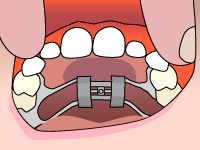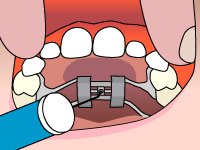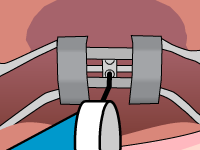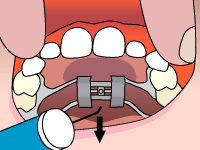Types of Appliances
Palatal Expander
The palatal expander "expands" (or widens) your upper jaw by putting gentle pressure on your upper molars each time an adjustment is made. The animation below will instruct you about when and how to adjust your expander. When you achieve the desired expansion, you will wear the appliance for several months to solidify the expansion and to prevent regression. There are two types of expanders, bonded and banded. The difference between them is shown in the videos below.
Bonded Rapid Expander
Mixed Dentition Rapid Palatal Expander
Turning the palatal expander
Below is the four-step way to turn the expander. You can also download these instructions in a printable PDF document.

Step 1
In a well-lit area, tip the patient's head back.

Step 2
Place the key in the hole until it is firmly in place.

Step 3
Push the key toward the back of the mouth. You will notice the fender will rotate and the new hole will appear. The rotation stops when the key meets the back of the expander.

Step 4
Press back and down toward the tongue to remove the key. The next hole for insertion of the key should now be visible.
Herbst Appliance
Aside from the obvious benefits of orthodontic treatment, like increased confidence and ease of hygiene, another benefit is not so obvious: improved jaw function. If your child has an overbite, simple treatment with braces will not correct the problem. The Herbst appliance, usually in conjunction with braces, is used to help the lower jaw develop in a forward direction. This eventually leads to an ideal bite. Left untreated, an improper bite may threaten the long-term health of your child's teeth, gums, and jaw.
A Herbst appliance is fixed to your child's molars. It includes a metal tube that connects the upper and lower jaw. By adjusting the tube, your orthodontist is able to control the jaw's position in relation to the upper teeth. Typical treatment time with a Herbst appliance is 12 months, though this may vary depending on your child's unique needs.
Differences Between Herbst and Headgear
Compliance
The main difference between a Herbst appliance and headgear is that the Herbst appliance is securely fastened to your child's teeth, while headgear is removable. To be truly effective, headgear must be worn between 12 and 16 hours per day, which often poses a problem with patients who don't like to keep it on that long. Since the Herbst appliance is not removable, you won't need to keep track of how many hours per day your child wears it.
Aesthetic
Another difference is aesthetics. Headgear is bulky, made of metal hooks or a facebow, and straps or a head cap to anchor the headgear to the back of the head or neck. A Herbst appliance is a much more discreet option: it may be visible when your child laughs or speaks, but it is far less obtrusive than headgear.
Adjusting to a Herbst Appliance
Muscle Tenderness – When your child first gets his or her Herbst appliance, there may be some overall muscle tenderness and soreness of the teeth. As your child's mouth adapts to the appliance, the soreness should fade.
Tissue Irritation – Because the Herbst appliance is metal, it may cause some slight tissue irritation, especially on the lower gums. It will take time for your child's mouth to adapt. Until it does, dental wax can help to ease the irritation.
Diet – Eating softer food will help with any muscle soreness, especially after the first week or two after getting the appliance. It is also important to eliminate sticky foods, like candy and gum, or hard, crunchy food, which can damage the appliance and lengthen treatment time.
Carriere® Distalizer™ Appliance

Creating a Corrected Bite Without Headgear
The Carriere Distalizer is an orthodontic device developed to correct a bite without removing permanent teeth when teeth have erupted incorrectly. With an effect similar to headgear, but without the use of a bulky appliance, the Carriere Distalizer pushes upper teeth back to create a corrected bite prior to the addition of braces. How does the Carriere Distalizer work?
- First, your orthodontist will create an anchor point, most commonly with a lower Essex Appliance, a passive lingual arch, full mandibular fixed appliance, or mini-screws. A Carriere Distalizer arm is then attached to the upper teeth on both sides of your mouth.
- An elastic band is attached from the upper bar to the lower back molars and should be worn at all times except when eating.
- With good elastic wear, your bite can be corrected in a matter of months, depending on the severity of your case.
- When the Carriere Distalizer arms are removed, we will place upper braces to finish correcting your bite and aligning your teeth to the perfectly straight, ideal smile you've always wanted.

 Website Powered by Sesame 24-7™
Website Powered by Sesame 24-7™